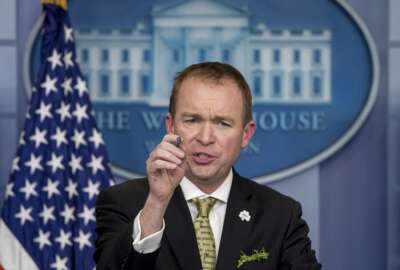 Exclusive
Exclusive To earn feds’ support on gov’t restructuring, OMB may need a different message
Though federal management experts like much of what they see in the Office of Management and Budget's reorganization and restructuring plan, they say the White...
In unveiling the details of its plan, Office of Management and Budget Director Mick Mulvaney said the President’s rhetoric of “draining the swamp” is synonymous with “government reorganization.”
But federal management experts say the White House could improve the message it’s sending to federal employees of its plan to overhaul and restructure the federal government, which will likely impact their agency’s mission and functions — and possibly their own jobs.
“The Trump administration needs to put a more positive face on the President’s Management Agenda,” David Walker, former Comptroller General at the Government Accountability Office, said during an April 18 panel discussion at the Government Performance Summit in Washington. “The President is a successful business person who doesn’t have prior government experience, and he has made some fairly harsh remarks with regard to the government and government workers.”
Mulvaney said restructuring and making government more efficient is part of “draining the swamp.”
“The President uses different words,” Mulvaney said during an April 11 briefing with reporters. “He doesn’t use the words, restructuring government, reorganizing government. He uses the words ‘drain the swamp.’ But that’s what this is. This is a centerpiece of his campaign and a centerpiece of his administration.”
But federal management experts, many of whom have said they like much of what they see in OMB’s restructuring plan, say the White House is sending mixed messages.
“I’m not sure that the voices that we’re hearing about deconstructing the administrative state or using evidence as the sole basis by which to eliminate a lot of programs in government … are coming from the same places as those trying to drive the management agenda,” said Robert Shea, a principal with Grant Thornton and a former management executive during the George W. Bush administration. “Nonetheless they get intermingled. Messaging this is about [being] positive.”
John Kamensky, a senior fellow with the IBM Center for the Business of Government, worked closely on a previous reorganization effort during the Clinton administration as the deputy director of the National Partnership for Reinventing Government.
Kamensky said the partnership put together a “gold card” that was signed by former President Bill Clinton and Vice President Al Gore. It read, “We will invent a government that puts people first by putting customers first, cutting red tape, empowering employees and cutting back to basics.”
“The idea there was let’s put a positive spin on some of the messaging to employees,” Kamensky said of the gold card. “Yes, ultimately there were 400,000 fewer federal employees at the end of the Clinton administration. Part of this was, how do we restructure and frame things?”
So far, communication between agency management and the workforce appears to be sparse. In a Federal News Radio survey of nearly 750 respondents, nearly 47 percent of federal employees said they received no information at all from agency managers since the President signed an executive order in March asking them to prepare for a government reorganization.
About 33 percent said they received little information, while 15 percent received some. Roughly 4 percent said they’d gotten a lot of information from agency managers.
“It’s a really important ingredient in the ability to communicate to an incredibly diverse, complex government constituency that you’re trying to move,” Shea said. “I speak to a lot of audiences, [and] I often ask whether they’re familiar with certain initiatives or outcomes that the federal government is trying to accomplish, and I often get crickets. We have to hammer these messages home, if they’re going to get out to the front lines, where people are genuinely making a difference in the lives of the American people.”
Ultimately, the administration’s reorganization plan is a push to get agencies talking and asking questions about the status quo, said Dustin Brown, acting deputy director for management at OMB. Personnel is one of those areas.
“It’s not about reducing the number of FTEs in an agency but actually looking at personnel costs,” he said. “We know a lot of examples of agencies that have identified opportunities to move employees, for instance, from the D.C. area out to regional offices as a way of getting better talent, frankly in some cases, as well as at lower costs.”
The President’s Management Council will drive much of the work on the administration’s reorganization effort. The council met recently and for the first time during the new administration, Brown said.
“I know we don’t actually have confirmed deputy secretaries in place who usually make up that group, but that’s not slowing us down,” he said. “We’re going with the acting folks that we have. We have acting deputy secretaries in every agency. We [brought] those people together. It was a very robust discussion. I think it’s one of the earliest President’s Management Council meetings in the beginning of the administration that we’ve had.”
The council has another meeting scheduled in May, Brown said.
Federal employees offered largely mixed opinions of OMB’s new plan in a Federal News Radio survey. Still, a third of federal employees said they supported the concept of restructuring, even if they don’t agree with OMB’s specific approach.
Copyright © 2025 Federal News Network. All rights reserved. This website is not intended for users located within the European Economic Area.
Nicole Ogrysko is a reporter for Federal News Network focusing on the federal workforce and federal pay and benefits.
Follow @nogryskoWFED
Related Stories






